Residents of large cities want to breathe clean air. And outside the window, the dust and stench of car exhaust, asphalt evaporation and industrial giants. The apartment has a cooker, a washing machine, and the floors are covered with long-pile synthetic carpets. All these are sources of harmful secretions that we breathe. There is a simple, although not cheap, means to solve the problem - supply and exhaust ventilation for an apartment and a private house.
- Operating principle
- Supply and exhaust ventilation device
- Specifications
- Manufacturers
- Using a recuperator
- Calculation of supply and exhaust equipment
- Definition of performance
- Determination of heating power
- Determination of cooling capacity
- Determination of the power of the steam generator
- Calculation of the diameter of the ducts
- Calculation of consumed electricity
- Supply and exhaust ventilation with your own hands
- Selection of equipment for air supply
- Installation of the supply unit
- Selection of equipment for air exhaust
- Maintenance and repair of the supply and exhaust system
Operating principle
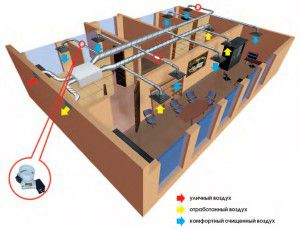
The principle of operation of the supply and exhaust ventilation is simple and effective. Exhaust air is drawn from the apartment, saturated with vapors, dust, carcinogens, unpleasant odors and allergens. At the same time, outside air is supplied, purified from all possible hazards and brought to a pleasant temperature.
The advantages of supply and exhaust ventilation at home are obvious:
- The apartment has clean air. By the way, the owners of such equipment are practically devoid of the need to wipe the dust! The installation removes up to 97% of all particles deposited on the surfaces of tables and sideboards;
- The equipment is environmentally friendly, it does not emit any harmful substances into the atmosphere;
- Apartment ventilation complies with fire safety standards;
- Installation allows you to create an ideal microclimate in your home, does not require constant attention and is controlled automatically.
The simple and understandable principle of operation made the supply and exhaust ventilation units the most demanded among the existing types of climatic technology.
Supply and exhaust ventilation device
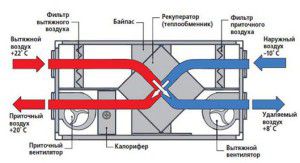
All installations of supply and exhaust ventilation for an apartment or house are divided into two types:
- monoblock;
- typesetting.
Monoblocks are produced from the conveyor completely ready for use. Just connect the air ducts with your own hands and the ventilation system is ready. Compact monoblocs take up very little space and are specially designed for installation in apartments.
Type-setting installations are assembled from individual components directly in the house. The characteristics of the components for supply and exhaust ventilation are calculated, as usual, taking into account individual requirements. The typesetting system provides wider functionality and automation capabilities. However, monoblocks benefit from their small size. Any installation is equipped with a timer that sets the parameters of the microclimate. For large offices and large country houses, a type-setting ventilation system is preferable.
What does the system consist of? We have arranged the elements in a logical order: from air intake to supplying it to the room:
- Air intake grille. Mounted on the outside at the inlet to the duct. Supplied with a net or grate from rodents, debris;
- Check Valve. Blocks the air duct from the penetration of cold air. It can be electrically or mechanically. Sometimes, instead of a valve, a manual or mechanical gate is installed;
- Filters. Located in air ducts. In the supply and exhaust ventilation systems of apartments, coarse filters with coal filler are usually used;
- Air heater or air heater. Heats the supply air before supplying it to the rooms. Electric air heaters are commonly used in home systems. Water heat transfer fluids take up more space, are more expensive and more complicated;
- Evaporator. Serves to cool the air in summer. They run on freon or water using a chiller system;
- Fan. Encourages air to move. The correct calculation of supply and exhaust ventilation largely depends on the characteristics of the fan;
- Sound absorber. When the fan is running, a noticeable hum is generated, which is drowned out by a silencer;
- Air ducts. Pipes for air transportation, can be of round or rectangular cross-section, of different thickness and of different materials, rigid or flexible;
- Distribution grilles and shades. Installed at the exit to the premises. Thanks to them, the air enters the room not in a single stream, but in pleasant thin streams;
- Automation controls all this equipment. Contains at least controllers for heating and fan speed;
- Sensors. Collect and submit data on the microclimate in the room: air temperature, humidity. Another group of sensors monitors the operation of the equipment;
- Recuperator. An important component of supply and exhaust ventilation, although not required. Allows you to save up to a third of the energy used for heating the supply air.
Specifications
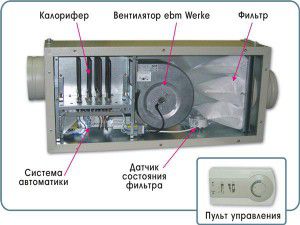
When choosing an air handling unit for ventilation, you need to pay attention to the following technical characteristics:
- Dimensions of the device. Very important for owners of apartments with limited space and low ceiling heights;
- Information on power supply. Most installations are powered from a standard 220 V / 50 Hz power supply;
- Device weight. It is necessary to provide for fasteners in advance;
- Fan rated power. Supply and exhaust ventilation power is one of the defining characteristics, measured in watts;
- Fan performance in cubic meters per hour;
- Output noise level in decibels. Although modern equipment works quite quietly, it is not superfluous to inquire about these parameters. After all, a home supply and exhaust ventilation unit is located directly in the apartment. Quite good indicators 24 - 38 dB;
- Air filtration degree. Depends on the type of filters, G is enough for an apartment;
- Presence and type of heat exchanger;
- Air duct diameter;
- Availability and capacity of air heating and cooling... Not all supply and exhaust ventilation units are equipped with heating and cooling;
- Control system type.
In addition to the technical characteristics of the supply and exhaust ventilation, the location is indicated: indoor or outdoor, the operating temperature range and the operating mode.
For supply and exhaust ventilation with a recuperator, the efficiency of the recuperator is specified, which on average is 90%
Manufacturers
Supply and exhaust ventilation units for apartments, cottages and offices of medium size are very widely represented on the market in a wide variety of price ranges.
| Brand name | Model | Producing country | Air consumption, cub.m. \ h | Average price, thousand rubles |
| Lossney | VL-100EU5 | Japan | 55-100 | 29 |
| Daikin | VAM 150-2000 | Japan | 150-2000 | 72 |
| Electrolux | EPVS-200-1300 | Sweden | 200-1300 | 41 |
| Dantex | DV 250HRE-1200HRE | China | 150-1200 | 29 |
| HERU | 90T-1600T | Sweden | 150-8000 | 88 |
| UNI | 4 REL EC | Norway | up to 720 | 148 |
| Breezart | 700 Roto | Russia | up to 750 | 229 |
Table 1. Some manufacturers of air handling units
Using a recuperator
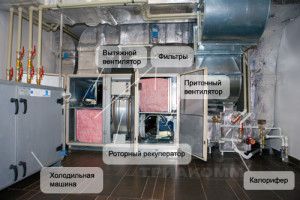
Supply and exhaust ventilation with a recuperator is the best that the market has to offer today. The recuperator uses the room temperature to heat the supply air from the outside.
There are 3 types of recuperators:
- rotary;
- lamellar;
- with intermediate heat carrier.
Although the rotary device is more efficient, plate recuperators are more often used in small air handling units. They are more compact and cheaper. Rotary recuperators operate at temperatures of -15 degrees and below, so they are good for outdoor installations.
Calculation of supply and exhaust equipment
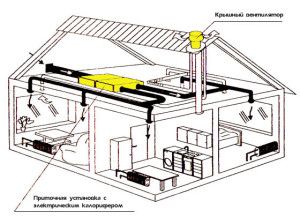
To make the right choice, you need to know the main technical characteristics of the supply and exhaust ventilation.
Definition of performance
We calculate the volume of each serviced room:
V=h*S,
here h - the height of the room, S - the area of the room.
We calculate the frequency of air exchange:
K=n*V,
here n - tabular value, for living quarters is 2.
We increase the obtained value of K by 25-30% and the capacity of the supply and exhaust ventilation is calculated.
Average performance values are:
- for apartments - 100 - 500 cubic meters \ hour;
- for country houses - 1000 - 2000 cubic meters \ hour.
Determination of heating power
W=0,36*O*T,
here O - the volume of passing air, Tz - average winter temperature.
Determination of cooling capacity
The previous formula is used, only the value changes T - for the summer.
Determination of the power of the steam generator
W=h*S*u
here h - the height of the room, S - the area of the room, u - the minimum humidity for a dwelling is 30.
Calculation of the diameter of the ducts
To calculate the cross-sectional area of ventilation pipes in a residential building or apartment, you can use simple ratios:
- for an apartment or a private house for 1 sq. meter of room area 5.4 sq. cm of the cross-sectional area of the pipe;
- for sheds and garages - 17.6 sq. cm.
Calculation of consumed electricity
It is possible to plan in advance the future costs of maintaining a home supply and exhaust ventilation.
Sm=(∆Td *K*c*Pd*Ld+∆Tn*K*c*Pn*Ln)*Nd/1000,
the long formula is pretty simple:
∆Td and ∆Tn - the difference between day and night temperatures, calculated separately for each month, you can see the values on the Internet,TO - installation power,from - heat capacity of air, constant 0.336,Ld and Ln - price of kilowatt / hour for day and night,Pd and Pn the length of the day and night in hours,Nd - the number of days in a month.
You can reduce energy costs by using a recuperator or VAV system. At the same time, the installation price increases by an average of 20%.
Supply and exhaust ventilation with your own hands
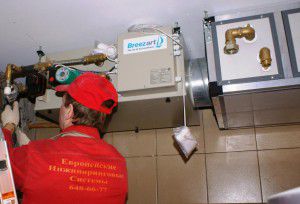
To assemble supply and exhaust ventilation for an apartment with your own hands, you must have not only locksmith skills, but also theoretical knowledge. Therefore, before making supply and exhaust ventilation in an apartment, weigh the pros and cons, consult with a specialist, and only then get to work. With your own hands in an apartment from separate compact devices, you can assemble a completely decent and working supply and exhaust ventilation.
The air supply is provided by a compact supply unit, and the air exhaust is enhanced by an exhaust fan, which is mounted in the air duct in the kitchen or in the toilet. The result is mechanical ventilation. The advantages of the proposed scheme:
- low cost;
- easy installation;
- no need to conduct air ducts;
- the equipment is installed without disturbing the decorative finish of the apartment;
- the power of the supply and exhaust ventilation is easy to calculate;
- repair of the combined supply and exhaust ventilation system will cost quite inexpensively.
And a little bit of tar: prefabricated ventilation with mechanical induction will work noisy due to the exhaust fans. When choosing the power of the devices, it is important to carefully balance the inflow and outflow, otherwise drafts, low pressure and other unpleasant phenomena for health are possible.
The use of mechanical traction on the hood can be dispensed with. Install a forced air supply, then the exhaust air will be "squeezed out" through the ventilation grills.
The result is a combined ventilation with heating, quiet operation and fully automated. And now a detailed instruction on how such ventilation is done in an apartment.
Selection of equipment for air supply

There are two types of supply units:
- compact;
- universal.
Compact ones serve only one room, are installed on a door or wall. The compact air handling unit works without air ducts. Air enters it through a hole in the wall or door, is filtered, warmed up and supplied to the room with the desired intensity. All parameters are set manually.
Universal are placed under a false ceiling or on a closed balcony. The installation will serve the entire apartment, but a duct network must be installed. This is the main difference from the compact one. Such equipment is more cumbersome, its installation is more difficult. Nevertheless, it is quite possible to independently make supply and exhaust ventilation in an apartment on the basis of a universal supply.
Plan the placement of the universal air handling unit before redecorating. Then the air ducts are easily hidden behind decorative elements.
Installation of the supply unit
If the choice fell on a universal supply unit, the first stage of work is choosing a place for it and laying air ducts. Flexible ventilation pipes are convenient, if a number of rules are taken into account during their installation, they will serve very effectively.
Avoid turns, if this is not possible, make them at an obtuse angle. The length of the air ducts should be as short as possible.
The supply unit is mounted near the outer wall, the smallest compacts can even be hung on the lower part of the balcony door.
Work progress:
- A hole with a diameter of about 10 cm is drilled in the wall (door) (see exactly the instructions for the device).
- In the hole we insert the supply pipe, previously wrapped with thermal insulation.
- From the side of the street we attach the grating.
- We hang the ventilation unit from the inside, fix it to the wall with self-tapping screws or dowels.
- We stretch the air ducts, if a universal supply is selected, we connect the power supply.
The first part of the supply and exhaust ventilation for the apartment has already been assembled by hand. Now let's take the exhaust air out.
Selection of equipment for air exhaust
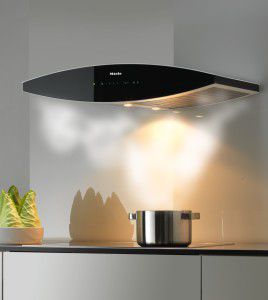
We will remove air from the most "polluted" rooms: a bathroom and a kitchen, using a time-tested exhaust fan.
Choose exhaust fans equipped with humidity and motion sensors. These appliances do their job better by using less electricity.
A fan is installed instead of an exhaust grille. It is advisable to equip the hood with a non-return valve. This inexpensive device is a plastic shutter on a horizontal axis offset upward. The valve blocks the air flow from the ventilation system, preventing backflow.
If the fan is equipped with sensors, the electric current is supplied to it continuously. Simpler models are powered from a light switch or started with a separate button. The second option is preferable for the kitchen.
It is impossible not to mention the device, which is widely used for the removal of exhaust air - kitchen hood. The efficiency of the hood is explained by the fact that it captures vapors and odors directly in the area of their appearance. When choosing, you should pay attention to the following parameters:
- view (flat, island, dome, built-in);
- dimensions;
- operating principle (recirculation or air extraction);
- performance;
- noise level;
- control method (touch or mechanical).
| Model | A type | Modes of operation | Productivity (m3 \ h) | Power (W) | Control type |
| Hansa OKS 653 SWN | dome | Branch \ circulation | 620 | 160 | Sensor |
| Hotpiont HLB 6.7 | built-in | Branch \ circulation | Buttons | ||
| Elikor 60 IX | dome | diversion | 430 | 185 | Buttons |
| Cata CN-600 | dome | Branch \ circulation | 583 | 80 | Buttons |
| Snindo Avior 60 SS \ BG | dome | Branch \ circulation | 800 | 238 | Sensor |
| Krona Kamilla 2M | built-in | Branch \ circulation | 550 | 200 | Buttons |
| Gorenie WHT961 | dome | Branch \ circulation | 755 | 288 | Sensor |
| Samsung HDC9A90 | dome | diversion | 861 | Sensor |
Table 2. Characteristics of some models of kitchen hoods
By installing exhaust devices, you get supply and exhaust ventilation with mechanical induction and heating.
Maintenance and repair of the supply and exhaust system
A mechanical supply and exhaust ventilation unit is a rather complex equipment that consists of many components. All of them must work in concert, if this does not happen, the supply and exhaust ventilation needs to be repaired. Additionally, the home system needs service, which includes:
- debugging of the main parameters;
- cleaning filters and air ducts;
- control of fire safety compliance.
If the equipment breaks down, we strongly advise against undertaking repairs yourself. All-in-one monoblocks have a guarantee. But even if the system is type-setting, the supplier (usually he and the installer) gives a guarantee for the equipment and installation work. Repair the supply and exhaust ventilation system only if you are very well versed in the issue, took part in the installation and own diagnostic equipment.
Video about a homemade recuperator for supply and exhaust ventilation:

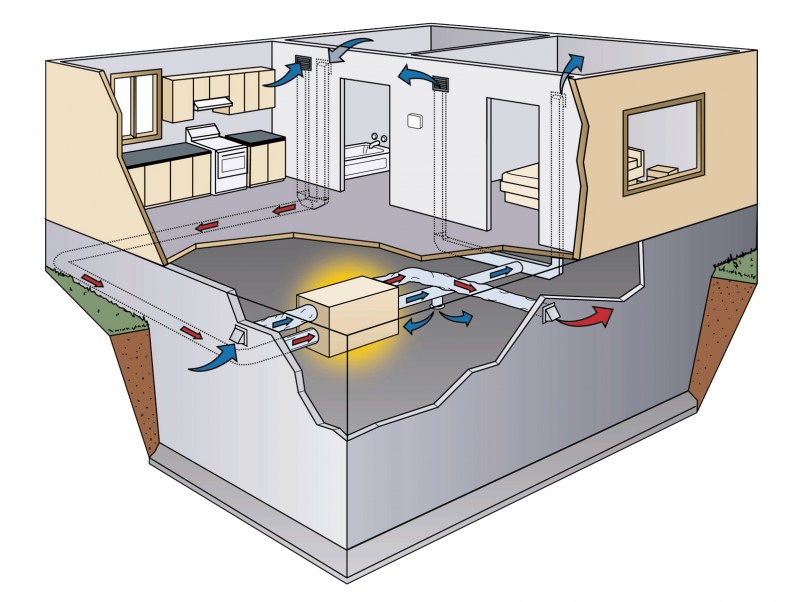
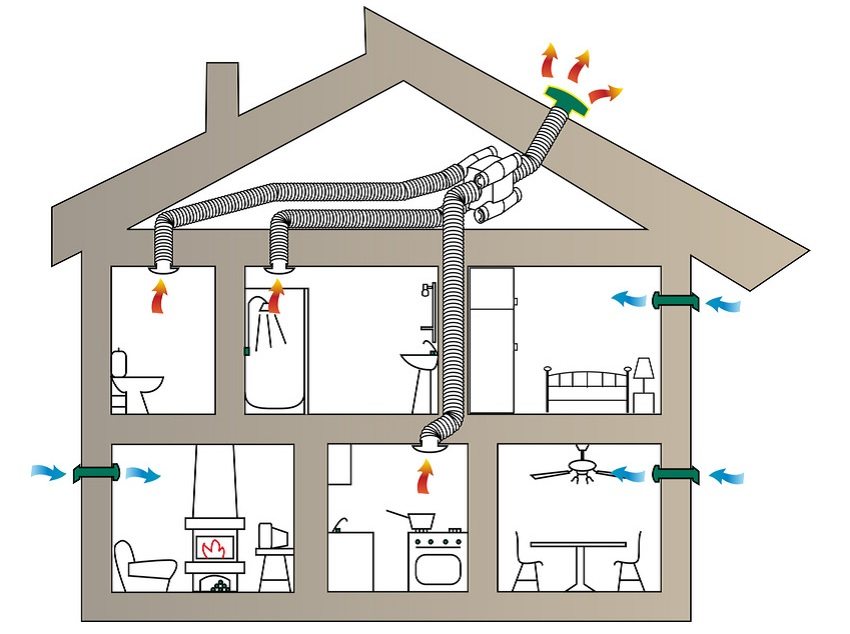
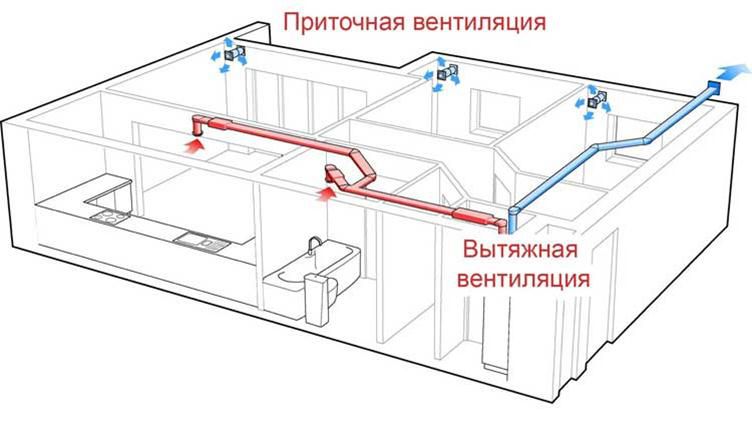
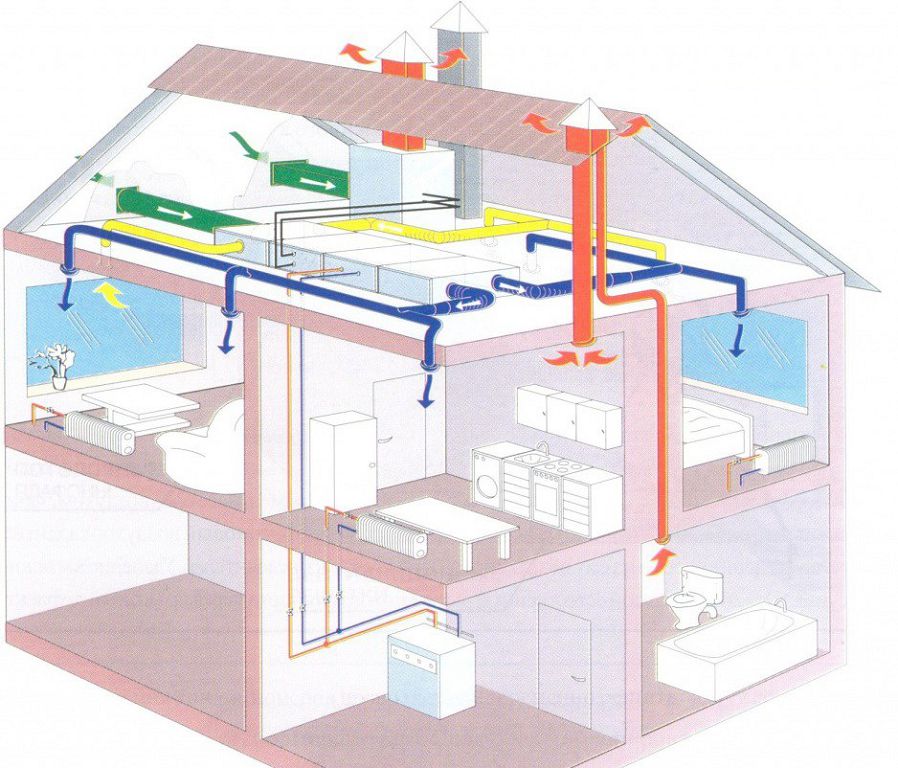
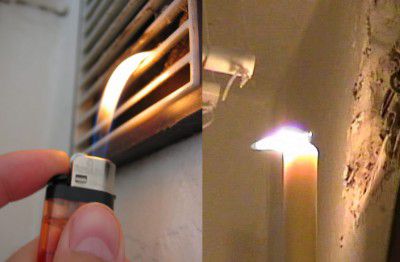
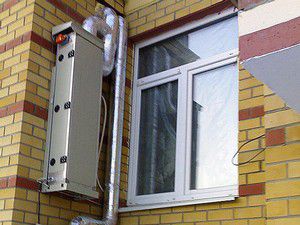

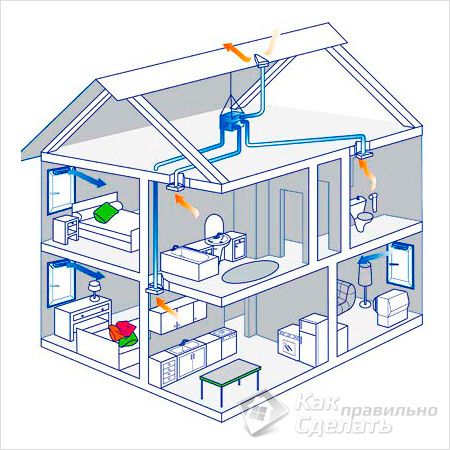
We need a calculation of the supply and exhaust system for a hot shop with an area of 200 squares.
For an approximate calculation, you can use a special calculator or contact the company at the place of registration of the object, they will help you make a calculation already on the spot for the necessary requirements.